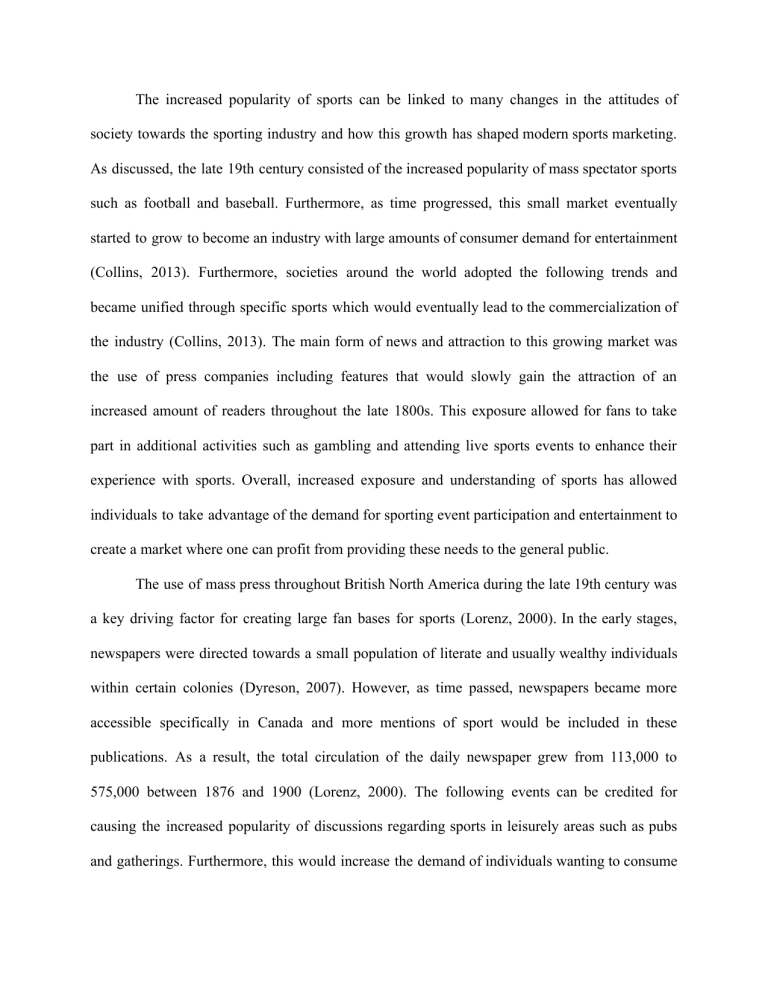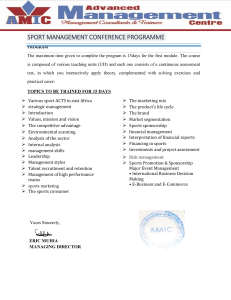
The increased popularity of sports can be linked to many changes in the attitudes of society towards the sporting industry and how this growth has shaped modern sports marketing. As discussed, the late 19th century consisted of the increased popularity of mass spectator sports such as football and baseball. Furthermore, as time progressed, this small market eventually started to grow to become an industry with large amounts of consumer demand for entertainment (Collins, 2013). Furthermore, societies around the world adopted the following trends and became unified through specific sports which would eventually lead to the commercialization of the industry (Collins, 2013). The main form of news and attraction to this growing market was the use of press companies including features that would slowly gain the attraction of an increased amount of readers throughout the late 1800s. This exposure allowed for fans to take part in additional activities such as gambling and attending live sports events to enhance their experience with sports. Overall, increased exposure and understanding of sports has allowed individuals to take advantage of the demand for sporting event participation and entertainment to create a market where one can profit from providing these needs to the general public. The use of mass press throughout British North America during the late 19th century was a key driving factor for creating large fan bases for sports (Lorenz, 2000). In the early stages, newspapers were directed towards a small population of literate and usually wealthy individuals within certain colonies (Dyreson, 2007). However, as time passed, newspapers became more accessible specifically in Canada and more mentions of sport would be included in these publications. As a result, the total circulation of the daily newspaper grew from 113,000 to 575,000 between 1876 and 1900 (Lorenz, 2000). The following events can be credited for causing the increased popularity of discussions regarding sports in leisurely areas such as pubs and gatherings. Furthermore, this would increase the demand of individuals wanting to consume sports content for entertainment purposes whether it was reading the latest updates in the daily news or attending a live game for a sport of their choosing (Howard 2018). This increased demand for content consumption and frequency would create the competition we can observe today between media companies that focus on the latest sports coverage. Therefore, the press had to ensure they had a larger reach to capture more readers which would inherently increase the overall interest and exposure of sports in society. Today, commentary and news on any sport can be found almost instantly amongst multiple sources which aim to provide content in a timely manner. Sports marketing and coverage has become so large and crucial to the industry to the point where there is a dedicated sports channel almost anywhere in the world such as ESPN which uses the slogan “Serving sports fans. Anytime. Anywhere.” The following changes allow modern day sports fans to constantly be kept up to date with the performance of their favorite sports team with the touch of a single button. These channels have found different methods such as advertisements and product sales to monetize their services to establish a loyal consumer base which will continue to grow. As mentioned previously, the increased exposure and interest of sports among society created a market where individuals could profit off the entertainment needs of others. Another form of generating revenue through sporting interest was gambling. Gambling is yet another driving factor which was important in the commercialization of sports and sports marketing to gain revenue from interested consumers. Gambling would be marketed as it is in modern society, if you bet on the correct individual or team to win, you have the chance of winning a greater reward compared to the amount you initially bet with. In the 19th century, gambling was seen as a method of making money outside of daily labor for the working class and it allowed people to partake in the act while enjoying themselves in social settings. However, many Protestant churches were against the act and did not approve of taking part in gambling (Huggins, 2020). Some of the earliest forms of sports gambling could be observed in horse racing which involved factors such as trainers, jockeys and different racecourses. Therefore, in some cases, it would not be as easy to gain profit on a bet due to the different factors that should be considered before making a decision. Another example of a sport where gambling played a large role in increasing exposure was cricket around the 1780s (Huggins, 2020). The following can be linked to the importance of the press and what was covered in the news. Many individuals would use the sports sections of a newspaper to conduct some form of research to gain a better understanding of the competitors within a certain sport. An example of this would be special racing calendars which would be very useful to those who were interested in the sport for entertainment or gambling purposes (Huggins, 2020). This information would allow them to make more informed gambling decisions which would increase in volume due to the increased amount of newspaper readers. Once again, sports gambling today is easily accessible and bets can be made from your mobile phone in the comfort of your home. Rules and regulations have also been modified throughout the years to ensure “fair play” for everyone involved. Sports gambling is now much more complex and requires individuals to conduct a fair amount of research on the sport of their interest before making a wise decision. There are multiple factors that affect how individuals may gamble today, however sports gambling as a whole has consistently grown into an industry which generates millions of dollars in revenue with ease. Certain companies have been able to enter the market and take advantage of the thrill seeking individuals who often gamble to ensure large scale profits across the globe. Lastly, the attraction of large live events allowed sporting events to grow in popularity throughout society. Throughout the 19th century, mass spectator sports events grew in popularity and paved the way for the commercialism of live sporting events (Collins, 2013). Stadiums or privately owned spaces of land would be used for several sporting events where the owners would charge fans a rate to experience a live sporting event. The following can be linked to the previous factors which were crucial to increasing the popularity of sport and sports marketing. Live sporting events could be announced in local papers and consumers could purchase tickets to enjoy an experience which was rare and enjoyable. Therefore, as the attraction for sports as an industry grew, the demand for a more enriching fan experience grew amongst the average consumer. This could be satisfied by those who had ownership of these facilities which would allow them to continuously profit from this increasing demand. An example of this would be the introduction of Polo in the United States which is what we would call floor hockey today. Polo was an adaptation of modern day hockey played indoors with roller skates (Hardy, 2006). The popularity of this sport grew throughout the 1800s and began to gain continuous coverage within newspapers (Hardy, 2006). As a result, during the years of 1884 and 1885, there was a large influx of roller rinks being built around Detroit to keep up with the growing interest of the sport. As a result, those who owned the rinks could use the space to profit off live audiences who would come to watch high skill matches or those who would use the space to practice (Hardy, 2006). Today, companies and sports teams own large and complex stadiums which are used as spaces where audiences can attend live games to support their home team or to just experience a fun and exciting event. Live sporting event spaces today use many strategies to gain revenue from this service which they use to invest back into the stadium or team and increase profit. Examples of this would be banner advertisements, food sales, and limited time team merchandise. Some sporting stadiums have been built in a manner which allows them to change the space to meet the conditions of several sports rather than building and maintaining multiple stadiums. Overall, the demand for experiencing a live sporting event was used as an opportunity to gain profit and has transformed event spaces today into complex and mesmerizing stadiums where fans can go to experience historic sporting events. In summary, elements of sports/sports marketing that are highly accessible and convenient today have gone through numerous changes which have created the highly profitable and exciting sporting industry that we have today. Sports coverage and advertising has become highly accessible and profitable which allows consumers to have access to multiple sources of information. Consumers can use this information to stay updated and take action to test their knowledge through gambling and increase the thrill they gain from being involved with sports fans. Finally, live sporting events are continuously becoming more entertaining with different elements which enhance the experience for individuals who have the interest in attending a sports event within the numerous stadiums that are available to them. Sport/Sports marketing has evolved in many ways which has given consumers the ability to enjoy experiencing the victories of their favorite teams in multiple ways while companies and organizations adhere to these needs in order to gain a profit. References Dyreson, M. (2007). Sport history and the history of sport in ... - jstor home. JSTOR. Retrieved January 27, 2022, from https://www.jstor.org/stable/43611752 Hardy, S. (2006). "Polo at the Rinks": Shaping Markets for Ice Hockey in America, 1880-1900 JSTOR. Retrieved January 27, 2022, from https://www.jstor.org/stable/i40144387Lorenz, Lorenz, S. (2000). 'a lively interest on the Prairies': Western ... - jstor home. JSTOR. Retrieved January 27, 2022, from https://www.jstor.org/stable/43609563 Howard, J. (2018). On sport, public history, ... - JSTOR HOME. JSTOR. Retrieved January 27, 2022, from https://www.jstor.org/stable/10.5406/jsporthistory.45.1.0024 Huggins, M. (2020). Associativity, gambling, and the rise of ... - Jstor Home. JSTOR. Retrieved January 27, 2022, from https://www.jstor.org/stable/10.5406/jsporthistory.47.1.0001
